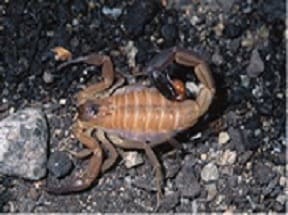Scorpions
Scorpions

Scorpions usually hide during the day and are active at night. They may be hiding under rocks, wood, or anything else lying on the ground. Some species may also burrow into the ground. Most scorpions live in dry, desert areas. However, some species can be found in grasslands, forests, and inside caves.
U.S. Geographic Region
Southern and Southwestern United States.
Symptoms
Symptoms of a scorpion sting may include:
- A stinging or burning sensation at the injection site (very little swelling or inflammation)
- Positive “tap test” (i.e., extreme pain when the sting site is tapped with a finger)
- Restlessness
- Convulsions
- Roving eyes
- Staggering gait
- Thick tongue sensation
- Slurred speech
- Drooling
- Muscle twitches
- Abdominal pain and cramps
- Respiratory depression
These symptoms usually subside within 48 hours, although stings from a bark scorpion can be life-threatening.
Employer Recommendations
Employers should protect their workers from scorpions by training them about:
- Their risk of exposure
- Scorpion identification
- How to prevent exposure
- What to do if stung
Worker Recommendations
Workers should take the following steps to prevent scorpion stings:
- Wear long sleeves and pants.
- Wear leather gloves.
- Shake out clothing or shoes before putting them on.
- Workers with a history of severe allergic reactions to insect bites or stings should consider carrying an epinephrine auto injector (EpiPen) and should wear a medical identification bracelet or necklace stating their allergy.
First Aid
Workers should take the following steps if they are stung by a scorpion:
- Contact a qualified health care provider or poison control center for advice and medical instructions.
- Ice may be applied directly to the sting site (never submerge the affected limb in ice water).
- Remain relaxed and calm.
- Do not take any sedatives.
- Capture the scorpion for identification if it is possible to do so safely.
